Introduction: Patricia Howe has kindly provided photographs of some early cable samples which came down in her family from E.J. Reid, grandson of one of the earliest telegraph engineers, William Reid.
Thanks also to Steve Roberts for his research contributions to this article, and to Texas MacDonald for the photographs of his Reid Brothers blasting box.
See also John Liffen‘s 2013 article on Telegraphy and Telephones, which has a detailed section on Reid Brothers. The article is behind a paywall, but you can send a request to the author and he may be able to send the file at no charge. |
| --Bill Burns |
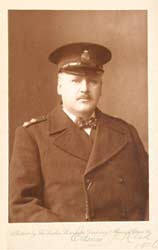
E.J. Reid in 1916 |
Patricia Howe writes:
Edwin James Reid, J.P., was my great uncle. He was the son of William Reid, telegraphic engineer, and the grandson of William Reid, one of the pioneers of telegraphy, who founded the business of Reid Bros., London, and laid the first submarine cables across the English Channel from Dover to Cape Griznez.
E.J. Reid became a partner in the firm in 1895. As he and his wife had no children of their own they brought up my mother’s elder sister, Edith Macaulay. When she died I inherited a piece of the Newfoundland/Cape Breton cable (with label still attached), plus a thick (3cm diameter) piece of cable and another piece of steel cable in a small lined leather case. I remember being told as a child that one of them was part of the first transatlantic cable.
 |
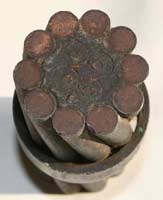 |
Four-conductor cable, similar to the cross-Channel cable of 1851,
but with an opposite lay of the armouring wires |
| |
 |
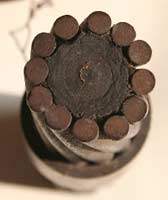 |
| 1856 Cabot Strait cable |
| |
 |
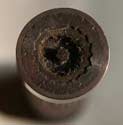 |
| 1858 Atlantic cable |
The photographs of E.J. Reid and the cable samples above
are courtesy of and copyright © 2008 Patricia Howe |
Steven Roberts, on his Distant Writing website, notes:
William Reid & Company, 25 University Street, London, makers of scientific instruments from 1820, who became telegraph engineers, manufacturers of telegraph instruments, underground troughs, and so forth, in 1836—the oldest telegraphic engineering firm, and one of the largest such, in Britain.
The firm was founded by William Reid, senior (Member of the Institution of Civil Engineers, Member of the Royal Institution and Fellow of the Royal Geographical Society), who was born in Glasgow, Scotland, in 1798. His workshops manufactured the initial commercial instruments for W F Cooke and Charles Wheatstone, subsequently providing equipment for the Electric, European, Submarine, Magnetic and other telegraph companies in Britain. Reid also manufactured electric clocks and chemical telegraphs to Alexander Bain’s patents.
The firm had become Reid Brothers by 1861, comprising William Jnr, James and Robert Nichol Reid. In 1862 the company also had premises at 3, 11, 13 & 14 Thornhaugh Mews, Tottenham Court Road, and “Standard Factory”, 12 Wharf Road, City Road. The business had concentrated at 12 Wharf Road, City Road, London by 1867.
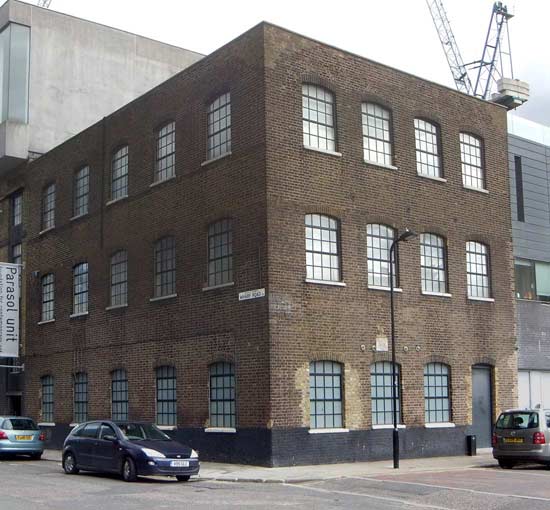
The premises at 12 Wharf Road in August 2014 |
It seems likely that the unusually numbered Thornhaugh Mews premises were overspill workshops for the instrument business; they kept them for several years. The Standard Factory was so called as it was on part of the large Standard Wharf on the City Road canal basin. Reid Brothers prospered as electrical engineers for many years, manufacturing electrical instruments and equipment in large quantities.
On 10 January 1910 a Certificate of Incorporation of Reid Brothers, Engineers, Limited was filed, and an agreement dated 24 January 1910 between James Reid and Edwin James Reid of 12 Wharf Road, City Road, in the County of London records that they were operating under the name of Reid Brothers and Reid Brothers, Engineers, Ltd.
The business evidently encountered difficulties over the next ten years, as a liquidator was appointed on 13 January 1921.
THE COMPANIES ACTS, 1908 TO 1917.
REID BROTHERS, ENGINEERS, LIMITED.
Extraordinary Resolution.
At an Extraordinary General Meeting of the members of the above named Company, held at 91/3, Bishopsgate, London, E.C.2., on Friday, the 13th day of January, 1922, the following Extraordinary Resolution was duly passed:–
"That it has been proved to the satisfaction of this meeting that the Company cannot, by reason of its liabilities, continue its business, and that it is advisable to wind up the same, and accordingly that the Company be wound up voluntarily, and that Mr. Harcourt Ashford, Chartered Accountant, of 91/3, Bishopsgate, London, E.C.2., be and he is hereby appointed Liquidator for the purpose of such winding up."
Dated the 13th day of January, 1922. |
E.J. REID,
Chairman
|
|
The firm possessed a remarkable collection of some of the earliest telegraphic instruments which, by implication, they had made. These included Bain’s electric clock 1845, Cooke & Wheatstone’s original two-needle telegraph 1843, Cooke & Wheatstone’s original one-needle telegraph 1846, Nott & Gamble’s dial telegraph 1846, Wheatstone’s magneto & bell machine 1840 and Wheatstone’s dial telegraph 1840.
A letter to The Mechanics Magazine from Reid Brothers noted that the first-ever instruments were still held by the company in 1861:
The Mechanics Magazine, 6 September 1861
TELEGRAPH INSTRUMENTS.
SIR,—We were the first telegraph instrument makers in this or any other country. Among the early specimens of telegraphy exhibited by us at the British Association to be held at Manchester on the 4th inst., will be found the two instruments that were employed in the detection of John Tawell for the murder at Slough on January 1st, 1845, on the Great Western line, and for which crime he was executed.
This being amongst the early achievements—in fact, the very first—where the electric telegraph showed its wonderful capabilities as a speedy messenger for the detection of crime, these two instruments (now become aged) have a degree of interest attached to them from early association with the infancy of telegraphy, bearing in mind they were the only two in existence at the time, long before the civilized world was encircled with its present web of wires.—We remain, Sir, yours truly,
REID BROS.
262, Gresham House, Old Broad-street, Sept. 2,1861. |
William Reid worked on the 1850 Channel cable and the 1853 Anglo-Irish Cable, among others, and made cable-testing tanks for the Gutta Percha Works. He also supplied troughs and conduits for landlines in the early 1850s, and conducted tests on the 1857 Atlantic cable during its manufacture at Birkenhead and Greenwich.
For the 1850 Channel cable, which was unarmoured and thus too light to sink to the bottom, Reid supplied lead weights to be attached to the cable every sixteenth of a nautical mile. The weights, flat rectangular blocks of lead weighing either eight or sixteen pounds, were made in two grooved halves which were pressed together over the cable and clamped with studs. The weights were applied to the cable as it was being paid out, the operation being interrupted for the fastening of each pair of weights. Remarkably, the cable survived this treatment, although it failed shortly after being laid.
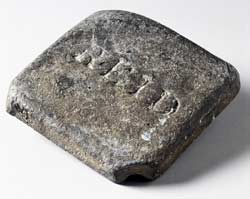 |
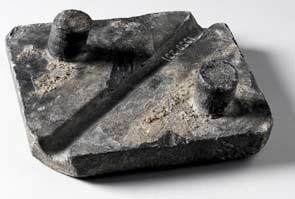 |
An unused example of a lead weight, marked Reid, made by Reid Brothers, Islington, London, England, 1850. Pairs of these weights were clamped to the cable at intervals of 100 yards (91.4 m) to ensure that it sank to the seabed.
Images courtesy of Science Museum - Information Age.
|
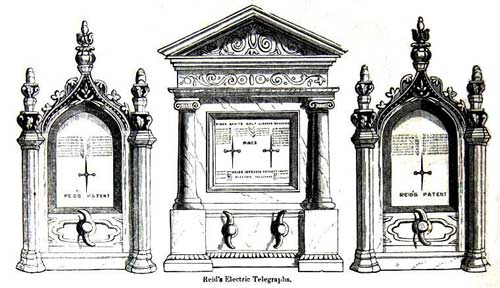
Reid’s Electric Telegraph instruments shown at the Great Exhibition in 1851 |
William Reid Senior lived at 63 Adelaide Road, Hampstead, London NW during the 1850s and 1860s with Mrs Matilda Reid and daughters Hannah and Jane. As William Reid, “engineer and machinist”, he started off as a philosophical instrument maker in the 1830s or earlier at 25 University Street, Tottenham Court Road, London. By 1856 the firm was called Reid Brothers, telegraph instrument makers, at the same address. William was still about in the 1860s, long after the firm had become Reid Brothers, comprising William Junior, James and Robert Nichol Reid.
The Times, 28 March 1856
ELECTRIC TELEGRAPHS.—REID, Brothers, 25 University-street London, machinists and telegraph engineers, respectfully give notice to telegraph and railway companies in this country and on the continent, that they have succeeded to the business of their Father, and continue to PREPARE and CONSTRUCT TELEGRAPHS, and guarantee the perfect working of the same. They have on hand a large and varied assortment of telegraph instruments for railway and commercial use, factories, coal mines, and domestic purposes. They would also call particular attention to their simple and cheap electric telegraph instrument for the use of the lecture table and public seminaries, by which the principle of this wonder-working agent may be explained and understood. They have always in stock a large assortment of telegraph wire in copper and iron, also covered with gutta percha. Iron and wood troughs, for underground telegraphs, of the best form and construction. Specimen of submarine cables, according to Reid’s original invention of 1850, and as laid across the Channel from Dover to Calais, Belgium, &c. Patterns of the best and most approved insulators in glass, china, and earthenware. Galvanic batteries in various forms, and on the most approved principles; also Reid’s patent glass troughs, consisting of 12 cells in one piece of glass. Tenders given and contracts entered into for the erection and maintenance of submarine, subterranean, and pole telegraphs. |
The overhead wires and submarine cables for the West Highland Telegraph’s Cantyre lines were all constructed during 1864 and 1865 by Reid Brothers, telegraph engineers and contractors, of University Street, London. In 1865 Reid Brothers laid cables in Scotland for the Universal Private Telegraph Company.
 |
 |
| Damaged landline insulator marked “Reid Bros London”, found in the sand on the beach at low tide at Ardmore Point, near Helensburgh, Scotland, by site visitor Joyce Garson.
Helensburgh was on the West Highland Telegraph’s Cantyre lines, which were constructed by Reid Brothers. |
The Universal Private Telegraph Company kept its stock of instruments and equipment at Wharf Road.
In 1876 Reid Brothers provided some historic telegraph equipment to the exhibition of a
loan collection of scientific instruments
at South Kensington, which was
opened by the Queen on the 13th of
May:
Passing along the collection sent by Her Majesty’s Postmaster-General, the attention is arrested by two large double-needle instruments in heavy mahogany cases, bearing brass inscription plates at their base.
These two instruments, contributed by Messrs. Reid, Brothers, were the means of bringing to justice Tawell, the murderer, and the Times of that date, 1844, observed that “had it not been for the efficient aid of the electric telegraph, both at the Paddington and Slough Stations, the greatest difficulty, as well as delay, would have been occasioned in the apprehension of the prisoner.”
James Mason:
The history of the year 1876, containing “The Year book of facts” and “The Annual Summary”
In the 26 May 1881 issue of the Journal of the Society of Telegraph Engineers and of Electricians, Reid Brothers were listed as exhibitors at the Electrical Congress in Paris, September and October 1881:
Reid Brothers, 12 Wharf Road, London, N.
Sole proprietors of Heaviside’s patent wire for the prevention of
induction in telepone circuits both in underground and suspended wires.
Sole licensees for Creighton’s patent insulator for fixing wires without
the use or aid of binding wire.
The Times issue of 22 December 1908 carried the obituary of Robert Nicol Reed: “of Camden-road, N.W., and of Messrs. Reid Brothers, telegraph and pneumatic engineers and contractors and instrument manufacturers, of Wharf-road, City-Road, N., who died on November 4th”.
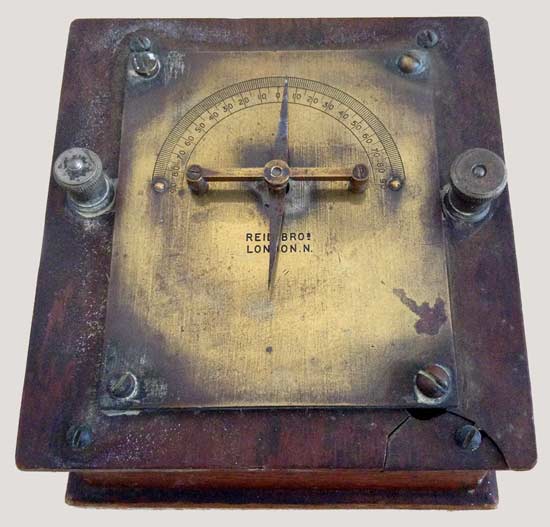
Above: An early telegraph galvanometer marked Reid Bros London N.
Below: Reid Bros Engineers Ltd telegraph galvanometer, made between 1910-1921 |
Steve Roberts adds this note on early blasting machines made by Reid Brothers:
One of the innovatory products made by Reid Brothers was the “Magnetic Exploder”, the first electrical machine for detonating explosives from a distance. It was invented by Charles Wheatstone in 1860 and included in his patent No 2,462 of that year. The Exploder was used in concert with an insulated copper wire and Frederick Abel’s “Magnet Fuze”, which was a tiny charge of ‘phosphide of copper’ in a gutta-percha casing ignited by electricity. The Exploder was a crank-operated magneto-generator using six small horseshoe magnets and six soft iron armatures rotating on a brass axis, weighing thirty-two pounds, in a wooden case that weighed an additional seven pounds. This earliest blasting machine could simultaneously ignite from two to twenty-five black powder or gun-cotton charges in tin cases or india-rubber bags over 600 yards distance with a single insulated wire. Up to four submarine charges in india-rubber bags could also be detonated at one time.
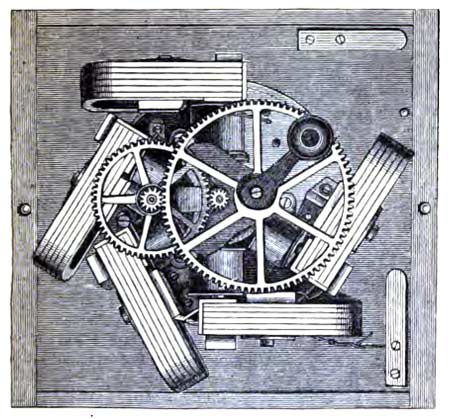
The Magnetic Exploder
Illustrations from The Student’s Text-book of Electricity
by Henry M. Noad, first published in 1867 |
 |
The Magnetic Exploder was widely used in colonial mining and was adopted in 1863 by the military in Britain . It was also imported into the Confederate States in 1864 from Reid Brothers to detonate submarine mines.
Latterly Reid Brothers made the common pull-push blasting machine, patented by Henry Julius Smith of New Jersey in 1878. In his initial patent Smith carefully gave Wheatstone credit for his electro-magnetic machine. Reid’s blasting machines to Smith’s pattern were used at least until the Great War.
| These images of a Reid Brothers blasting box dated 1914 were provided by site visitor Scott Pedlar. |
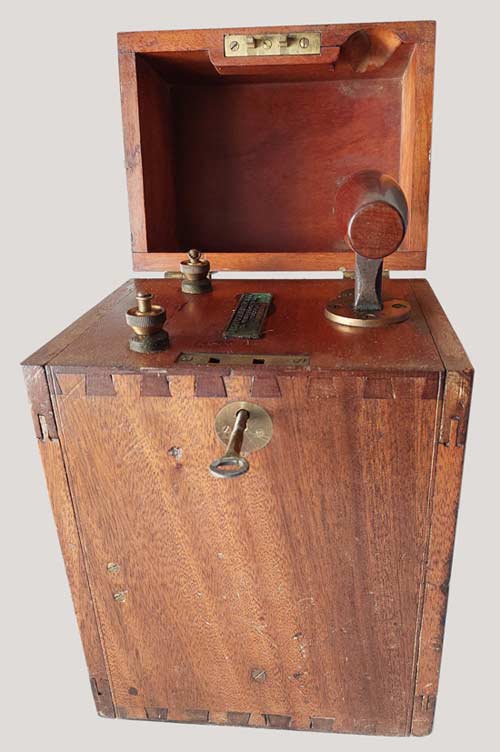 |

Detail of nameplate on top panel:
REID BROS. ENGINEERS. LTD
12. WHARF RD. CITY RD.
LONDON. N.
No. 297 V 1914 |
|

